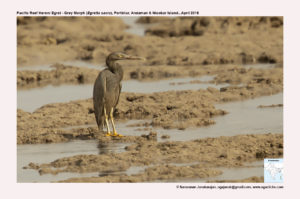Pacific Reef Egret – Grey Morph

Pacific Reef Egret Egretta sacra
Etymology:
- Egretta : French word French Aigrette for egret
- Sacra : Latin word for “Sacred”
Distribution in India: Resident of Andaman and Nicobar Islands in India.
Description: Size of 58–66 cm; Wt. of 330–700 g; wingspan of 90–100 cm. It is polymorphic, with white and dark grey morphs. The white morph has pure, all-white plumage, albeit sometimes with a few dark streaks, while the latter varies in coloration, from slate-grey to brown-grey including the underwing, with variable numbers of white feathers on chin and sometimes throat. The intermediate forms also occur, although considered to be rare. The male is larger than female (wing length 275–292 mm versus 268–279 mm in female). It has short stout legs projecting beyond tail in flight and thick bill distinctive; both are all-yellow during the breeding season and a short, inconspicuous crest. The non-breeding adult lacks ornamental plumes on foreneck and back and has duller bare parts, with bill ranging from dirty yellow to dusky or grey-brown, with blackish to greenish-horn maxilla; lores are yellow-green in white morph and grey-blue in dark morph. The legs are very variable from yellow, greyish yellow, greenish yellow or brownish yellow, and darker in front and paler behind, while the feet are yellow-green with bright yellow soles. The juvenile lacks plumes and has paler bare-parts colours. The lores are greener, bill is duller and legs are more olive and less obviously bicolored. The dark morph juvenile is paler and browner, sometimes with pale-scaled underparts, while white morph is similar to adult, although plumage may appear more patchily dark-flecked.
Habitat: It is found in coastal, especially rocky shores, coral reefs and offshore islands, estuaries, mangroves, mudflats and sandy beaches, fields, freshwater marshes, rice fields and garbage dumps. It is found from sea-level, up to 400m but always near the sea.
Food habits: It eats small crabs and fish like Mudskippers, gobies, blennies and damselfishes, molluscs, insects, lizards, tern chicks or forces adult terns to regurgitate prey. It feeds by day or night, depending on tide. It is an active feeder, usually by Walking Slowly, but also Walking Quickly, Running or Hopping, and using techniques such as Wing Flicking, Spread Wing, Gleaning, Foot Stirring, Foot Paddling, Foot Dragging, Hovering and Diving to secure prey. It feeds alone or in pairs, occasionally in family groups or larger groups if food is particularly abundant. It is highly territorial, each bird defending feeding territory. There are some differences apparent between morphs, particularly in habitat choice and foraging behavior, the white morphs tend to feed in surf, whereas dark birds choose to run and walk along reef flats in search of prey.
Breeding habits: They breed in India, May–Jul, Sept; in Malaysia May, Jun and Nov; in West Java, Sept–Apr; in New Zealand, Sept–Dec, in New Caledonia, Jan–Feb; in Australia, year-round. They nest singly or in small colonies, sometimes in mixed colonies with other species. The nest is built on ground, cliff ledges, bushes or small trees. The nest is constructed of sticks, lined with leaves and grass, and typically. They lay a clutch of 2–3 eggs. The incubation period is 25–28 days. The incubation is done by both adults. The fledging period is 50 days. The young leave nest at 3 weeks.